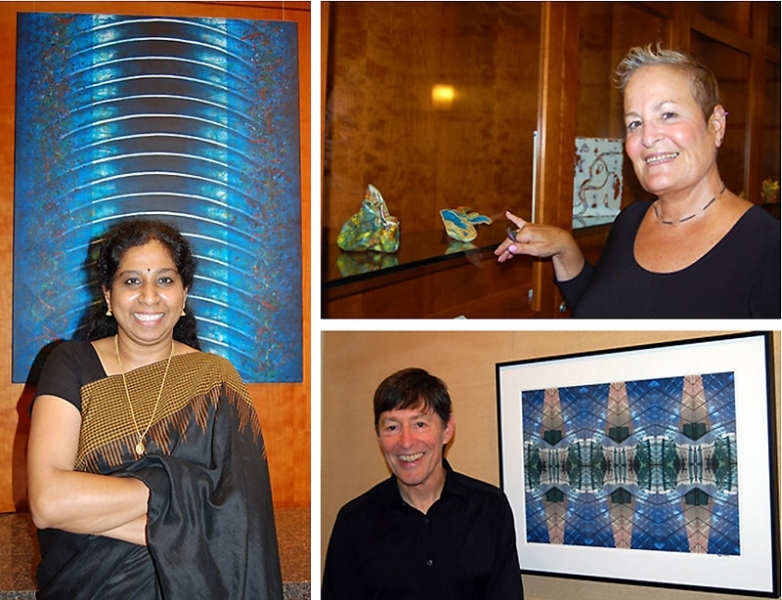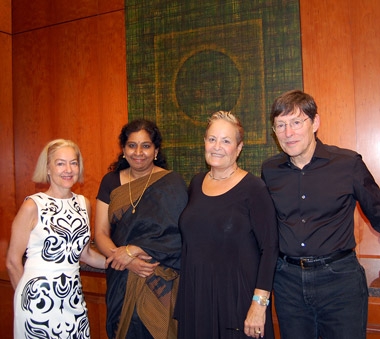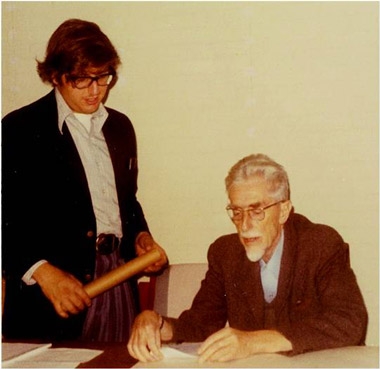Many in the science community have a strong appreciation for art, and many artists are inspired by the wonders of science. The biannual art exhibitions that are hosted at the American Center for Physics (ACP) express this symbiotic relationship. On October 14, the ACP community welcomed Art Curator Sarah Tanguy and three talented artists for the opening of ACP’s 35th Art Exhibit, Density Fluctuations.
In Tanguy’s words: Central to Shanthi Chandrasekar’s paintings, Stephen Schiff’s photographs, and Ellyn Weiss’ sculptures and small mixed media work is the concept of metamorphosis. With inspirations from nature, architecture, cellular biology, Hinduism, and even the cosmos, the three artists share an interest in probing underlying patterns whose shifts and permutations create eye-dazzling puzzles. Full of energy and surprise, their works stir the imagination on a transcendent journey of discovery.

Each of the artists made excellent presentations, introducing their work and giving the attendees insight into their backgrounds, motivations, and techniques. Sculptor Ellyn Weiss described her fascination with conceptualizing what might be revealed as the Arctic ice melts. Her layered works of colored wax were inspired by physicist Henry Kendall and by her earlier work as a lawyer with the Union of Concerned Scientists. She said, “At the microscopic level, everything is beautiful.” And by everything, she specified even tar (hydrocarbons) and viruses.

Painter Shanthi Chandrasekar happily admitted that exhibiting her work in a physics building has been a life-long dream. She grew up in a community of scientists who worked at a laboratory associated with India’s Department of Atomic Energy, and has degrees in both physics and psychology. Chandrasekar also studied Sanskrit, a liturgical and philosophical language of Hinduism, because of its deep connections to science and nature; this influence appears in several of her works.
Stephen Schiff also studied physics, as well as astronomy, and his appreciation for science pops in his series of tessellations. The visual enigmas of Dutch artist M. C. Escher compelled him to practice art, which he performs both behind the lens of his camera and in front of his monitor screen. Schiff walked the audience through his creative process, starting with an architecturally alluring photograph taken during one of his many trips abroad and manipulating it into a tile, which he then replicates with a series of processing. What results, according to Tanguy, is a “display of the phenomenon of emergence.”
Stephen Schiff’s remarks about the influence of M. C. Escher particularly appealed to Gary Arlen and Bonnie Lee Holland of Bethesda, who attended the presentations.

As newlyweds, they visited Escher at his home and studio in the Netherlands in the early 1970s, shortly before his death. Gary and Bonnie had also been attracted to Escher’s work while they were in college. Through their contacts in DC, they were able to arrange to spend an afternoon with Escher, discussing his life and work. (Gary Arlen was kind enough to share a photo with the AIP Matters audience. The editors assure you that Arlen himself provided the caption!)
This week in Baltimore, AVS members are convening for their 61st International Symposium and Exhibition, and they have three focus topic sessions dedicated to Conservation Studies of Heritage Materials. Several talks in these sessions are devoted to exploring the mediums used to create works of art and methods of preserving art and artifacts.
